As things would have it, the first display we’re reviewing in 2017 is an OLED TV, perhaps heralding the many TVs using this self-emissive technology that we can expect for the year ahead. Today we’re testing the Philips 55POS901F/12, a flat-panel OLED which is the first from the brand now managed by Amsterdam-based TP Vision.
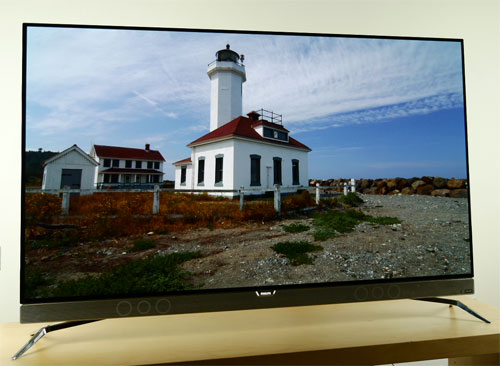
The Philips 901F comes only in one screen size of 55 inches, and features an UHD (ultra high-definition) resolution of 3840×2160, three-sided Ambilight technology, as well as Android Smart TV system. In terms of HDR (high dynamic range) playback, the 55POS901 carries Ultra HD Premium certification from the UHDA (UHD Alliance), and supports HDR10 format from Ultra HD Blu-ray and 4K streaming services such as Netflix and Amazon Prime Video, but not Dolby Vision (even though there’s a Dolby logo at the bottom right of the inbuilt soundbar).
At this time of writing (February 2017), we’ve been informed that the set can be firmware-upgraded to support HLG (Hybrid Log-Gamma) which is the front-running HDR broadcast standard, but whether the software update will be rolled out is still under consideration.
| Macro photo of subpixel layout confirming WRGB OLED panel from LG Display |
It’s no secret that the Philips 55POS901F uses a WRGB OLED panel from LG Display, the sole vendor of TV-sized OLED panels on the market at this moment in time. While some people believe there won’t be any difference in picture quality between OLEDs from different TV manufacturers since the underlying panel is the same, we actually saw improvements in several areas in a side-by-side comparison against a 2016 LG OLED which happened to be in our test room for review at the same time.
Although the near-black gradation of LG’s 2016 OLEDs was improved over the company’s 2015 models, it’s still not as clean as that seen on plasmas and LED LCDs, making many video enthusiasts wonder if it’s an inherent OLED flaw that cannot be overcome. After spending extensive time testing and comparing Philips’ 55POS901 beside a 2016 LG OLED (both calibrated), we’re extremely pleased to report that this theory is simply not true.
In almost every dark scene that’s compressed (and all consumer video formats use some sort of compression however light), the Philips OLED manifested less macroblocking and dithering noise than LG’s. For example, in the final act of Skyfall (one of the best Blu-ray transfers of all time) as the main villian (Javier Bardem) made his way up to the chapel, the above-black regions looked cleaner and less pixelated on the 901F compared with the LG:
 |
| Left: LG 2016 OLED; Right: Philips 55POS901F |
The near-black uniformity of WRGB OLED panels has got better from one generation to the next, and the POS901F is the best yet we’ve seen in this regard, at least on our review sample. Putting up 1% to 4% above-black rasters, we observed no vignetting, and only a very very slight brightening along the sides. The thin vertical streaks that could be spotted at certain low-luminance levels on previous OLEDs were all but gone too.
Unlike LG’s 2016 OLEDs, Philips doesn’t provide a user menu control to manually trigger the OLED compensation cycle, so any self-correction will automatically take place in standby after a specific number of operation hours has been accumulated. To lower the risk of image retention and screenburn, the 901 gradually dims its screen when a static image is displayed.
The Philips 55POS901F/12 offers two motion-affecting options in its picture menu, namely [Perfect Natural Motion] and [Perfect Clear Motion]. The former is essentially motion-compensated frame interpolation, and comes in three intensities of “Minimum“, “Medium” and “Maximum” besides “Off“. Even the lowest [Perfect Natural Motion] setting of “Minimum” introduced noticeable soap opera effect (SOE) to 24p movies as well as interpolation artefacts, so we left it off.
Engaging [Perfect Clear Motion] was far more useful, boosting motion resolution (as determined via Chapter 31 of the FPD Benchmark Software test disc) from the sample-and-hold baseline of 300 lines to 650 lines. Running our torture tests, we couldn’t detect any interpolation artefacts or SOE, and there’s no visible flicker and drop in light output that are normally associated with black frame insertion (BFI) either.
Click on the options below to compare blur from motion pursuit camera test:
[Perfect Clear Motion] “Off” | [Perfect Clear Motion] “On”
![[Perfect Clear Motion]](https://www.hdtvtest.co.uk/news/wp-content/uploads/2018/04/uhdtv_Philips-55POS901F_pcm-off.jpg)
We’re still investigating how TP Vision/ Philips has achieved this, but from watching many football matches on the 55POS901, it delivered the sharpest, artefact-free motion we’ve witnessed from a 4K OLED television to date. Some LCD-based displays from Samsung and Sony could reach a motion resolution of 1080 lines (or higher) with the help of BFI +/- interpolation, but OLED’s near-instantaneous pixel response time meant that there’s no dark-coloured smearing (which can affect VA-type LCD panels) at all.
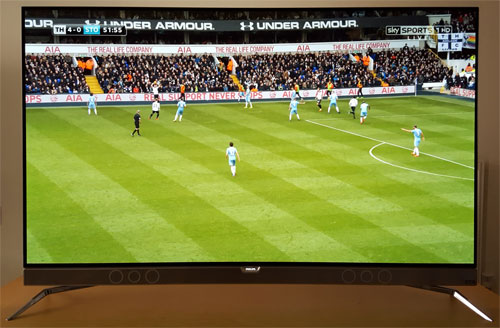
Another reason why you should never switch off [Perfect Clear Motion] is we saw more telecine judder on slow panning shots in 24fps films with it disabled, suggesting that the setting also performed 5:5 pulldown function.
Some OLED TV owners prefer to watch in pitch-black conditions, a stance we completely understand since it allows for full appreciation of the absolute 0 cd/m2 blacks produced by this self-illuminating display technology. However, as one scene cuts from dark to bright and vice versa, our pupils have to constrict and dilate in response to the brightness on screen, and over prolonged periods of viewing this can get pretty fatiguing.
This is where Ambilight (TP Vision/ Philips’ marketing name for the company’s integrated bias lighting system) comes in handy. By providing a baseline level of background illumination, Ambilight stops our pupils from working overly hard, thus reducing eye strain. We advise going for the [ISF Warm White] option, and turning [Brightness] down to avoid overpowering shadow detail which can already look slightly indistinct on OLEDs.
Whilst LG OLED televisions needed several firmware updates and specific tweaks in the picture menu for better tone-mapping, the Philips 901F was already good to go (for the most parts) in its [HDR Movie] mode, the preset for which the TV has been certified UHD Premium. Peak brightness hit 640 nits, and DCI-P3 coverage came in at 99% – both parameters comfortably exceeding the minimum specs outlined by the UHDA.
With the default out-of-the-box settings in [HDR Movie] mode, the 55POS901F tracked the ST.2084 PQ (perceptual quantisation) EOTF (electro-optical transfer function) standard accurately up until around 400 nits, after which the display began to tone-map to resolve more highlight detail beyond its peak brightness capability.
![PQ EOTF tracking in [HDR Movie] mode](https://www.hdtvtest.co.uk/news/wp-content/uploads/2018/04/uhdtv_Philips-55POS901F_pq-eotf.png) |
| PQ EOTF tracking against ST.2084 standard in [HDR Movie] mode |
Interestingly, the TV’s [Colour control] CMS (colour management system) became unavailable in HDR mode, but two-point white balance calibration was sufficient to obtain reasonably accurate greyscale and colours, though we had to increase the [Colour] value by a few clicks to fix the initial undersaturation.
![Post-calibration RGB Tracking in [HDR Movie] mode](https://www.hdtvtest.co.uk/news/wp-content/uploads/2018/04/uhdtv_Philips-55POS901F_hdr-rgb.png) |
| Post-calibration [HDR Movie] mode RGB tracking and delta errors (dEs) |
![Post-calibration colour saturation tracking in [HDR Movie] mode](https://www.hdtvtest.co.uk/news/wp-content/uploads/2018/04/uhdtv_Philips-55POS901F_hdr-strack.jpg) |
| Post-cal HDR colour tracking against DCI-P3 standard within Rec.2020 container |
We sampled our collection of 4K Blu-rays on the Philips POS901F, and were very happy with what we saw. For discs that are mastered to 1000 nits, the OLED television – blessed with pixel-level light control – was more than a match for flagship LED LCD TVs, correctly resolving bright highlights up to 1000 nits while rendering dark scenes without any elevation in black level or introducing haloing/ blooming artefacts around the LED LCDs’ dimming zones.
Colours appeared natural enough, and 2160p/24 panning was smooth. Like LG’s OLED TVs, the 55POS901 exhibited minor posterisation in certain scenes (e.g. the skies in The Martian, The Revenant and Kingsman); Panasonic and Sony HDR televisions are still better in this respect, especially with the latter’s [Smooth Gradation] feature.
Where the top-tier full-array local dimming (FALD) LED LCDs overtook the Philips 901 was in movies mastered to 4000 nits: the electricity blasts in The Amazing Spider-Man 2 and the lightning bolts in Mad Max: Fury Road simply looked more realistic and impactful on the 1250-nit Panasonic DX902, 1600-nit Samsung KS9500 and 1800-nit Sony ZD9.
TP Vision has worked hard to improve gaming responsiveness on Philips TVs (admittedly all LCD-based displays) over the past few years, so we’re surprised to see an input lag figure of 59ms (measured using a Leo Bodnar tester) in [Game] mode on the 55POS901F/12.
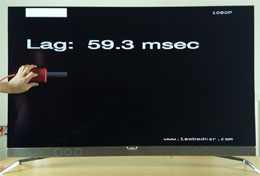 | 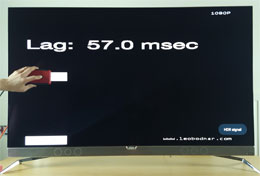 |
| Input lag in [Game] mode | Input lag in [HDR Game] mode |
Although there’s a dedicated [HDR Game] mode for playing HDR games, lag time wasn’t much better, coming in at 57ms. Choosing a TV for gaming has descended into a numbers game, and whilst the 901F’s latency wasn’t the worst, many 2017 sets will be aiming for 20ms or even quicker to appeal to gamers.
Some of the best 3D we’ve experienced have been provided by 4K OLEDs, so we’re slightly disappointed that the 55POS901F didn’t support any stereoscopic format. Then again, none of the 2017 models from major TV makers except Panasonic’s EX750/ EX780 will support 3-D, so perhaps we should instead be applauding TP Vision for their foresight.
What’s more likely to put off prospective buyers is the lack of Dolby Vision. Even though we have yet to be convinced by the theoretical superiority of Dolby Vision (owing to dynamic metadata) until we can do more side-by-side comparison once DV content becomes more widely available, the average person will be seeking some degree of future-proofing when spending this much money on a high-end TV. Time will tell.
Like all Philips TVs we’ve reviewed to date, the 901F provides only two-point greyscale controls and a 2-axis colour management system with [Saturation] and [Hue] but no [Luminance] adjustments. While we successfully calibrated the TV to deliver fairly accurate colours using a profiled Klein K10-A meter and Portrait Display’s CalMAN 2016 software, in some darker sequences we could see the odd purplish tinge creeping in compared with rival sets from other brands who offer 10- or even 20-point white balance controls.
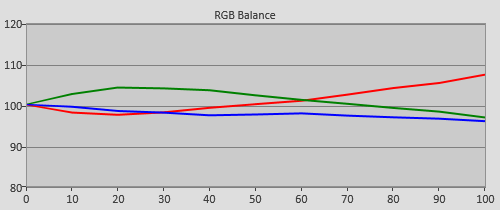 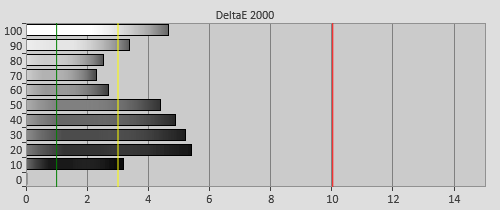 |
| Pre-calibration [ISF Night] RGB tracking and delta errors (dEs) |
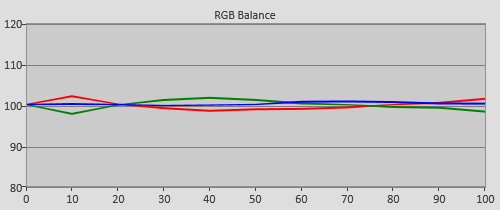 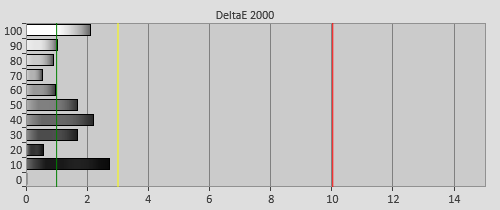 |
| RGB tracking and dEs after [Custom colour temperature] calibration |
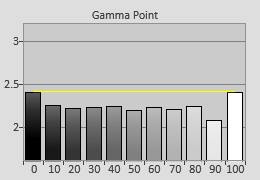 | 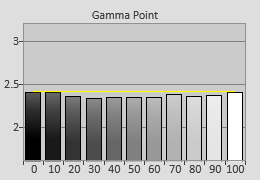 |
| Pre-calibration gamma tracking (2.21) | Post-calibration gamma tracking (2.36) |
![Post-calibration colour saturation tracking in [ISF Night] mode](https://www.hdtvtest.co.uk/news/wp-content/uploads/2018/04/uhdtv_Philips-55POS901F_post-strack.jpg) |
| Post-cal colour saturation tracking against Rec.709 standard |
![Post-calibration colour errors in [ISF Night] mode](https://www.hdtvtest.co.uk/news/wp-content/uploads/2018/04/uhdtv_Philips-55POS901F_post-strack-de.png) |
| Post-calibration colour errors (<3 not appreciable to the eye) |
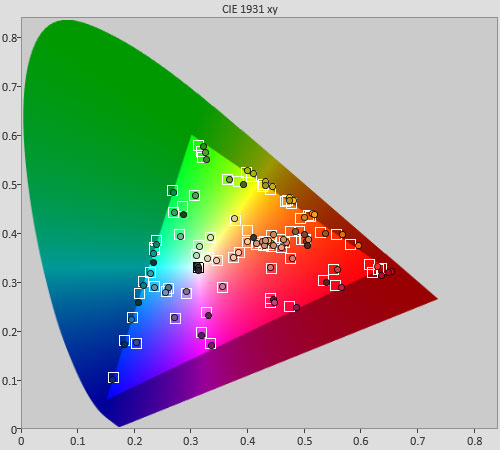 |
| Post-calibration Colour Checker SG test |
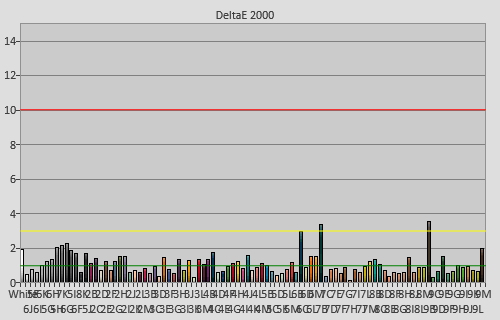 |
| Post-calibration Colour Checker SG errors (<3 not appreciable to the eye) |
Note that within any single picture preset, the settings are shared between SDR and HDR modes. Furthermore, the 55POS901 stays on the corresponding picture preset when you switch between SDR and HDR modes (for instance, when you get out of [HDR Movie] mode to watch SDR, you’ll end up in [Movie] mode), requiring manual switching if you have different picture presets calibrated for SDR and HDR respectively (as it should be).
As upmarket as the 55POS901F’s design is, some viewers may find it difficult fitting the television into their existing setup. As is in vogue these days, the Philips 901F is held up by two feet located at both ends of the OLED panel, with the points of support extending even beyond the width of the screen itself.
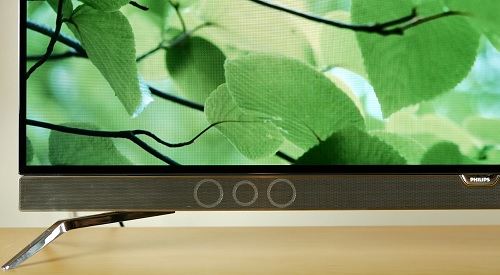
In other words, if your current AV furniture isn’t at least 122cm wide, you’ll have to get a new one, or go the wall-mount route.
| Dead pixels | None |
| Screen uniformity | No vignetting; minimal brightening & vertical streaks |
| Overscanning on HDMI | 0% with [Picture Format] set to “Original“ |
| Blacker than black | Passed |
| Calibrated black level (black screen) | 0 cd/m2 |
| Calibrated black level (4×4 ANSI) | 0 cd/m2 |
| Black level retention | Mostly stable |
| Primary chromaticity | Very good |
| Scaling | Very good |
| Video mode deinterlacing | Good jaggies suppression |
| Film mode deinterlacing | Passed 3:2 & 2:2 in SD; and 3:2 in HD |
| Viewing angle (cone) | 166° |
| Motion resolution | 650 with [Clear LCD] on |
| Digital noise reduction | Optional |
| Sharpness | Defeatable edge enhancement |
| Luma/Chroma bandwidth (2D Blu-ray) | Full Luma & Chroma with [Computer] on |
| 1080p/24 capability | No judder |
| 2160p/24 capability | No judder |
| Measured panel refresh rate | 120Hz |
| Measured peak brightness | 640 cd/m2 |
| Measured DCI-P3 coverage | 99% |
| Leo Bodnar input lag tester | 59ms in [Game] mode; 57ms in [HDR Game] mode |
| Full 4:4:4 reproduction (PC) | Yes with [HDMI Ultra HD] set to “UHD 4:4:4/4:2:2” and [Computer] mode engaged |
| Out-of-the-box [Standard] mode | 132 watts |
| Calibrated [ISF Night] mode | 101 watts |
| [HDR Movie] mode | 266 watts |
| Standby | <1 watt |
The 55POS901F/12 is a stunning OLED debut from Philips. Not only is it the best television we’ve tested from the company, the combination of improved above-black qualities and superior motion sharpness also translated into the most impressive picture we’ve seen yet from a 4K OLED.
Some OLED TV owners already believe that the image quality of their sets has surpassed PDPs (plasma display panels), but for others, near-black uniformity/ gradation and motion clarity granted by impulse-type driving remain the last bastion of plasma. Philips’ first OLED goes some way towards bridging the gap, and if you accept the premise that OLED is superior to plasma thanks to true blacks, brighter light output, higher resolution and no PWM noise, then an argument could even be made for the 55POS901 to be right up there with the best TVs ever produced.
At a retail price of £2,799, the Philips 901F is significantly more expensive than LG’s OLED55B6V which boasts lower input lag, more accurate calibrated greyscale and Dolby Vision compatibility no less. But buying high-end AV equipment has always been subject to the law of diminishing returns, and if you’ve been frustrated by the near-black, motion and HDR tone-mapping deficiencies on LG OLEDs, the 55POS901F is the only consumer OLED TV on the market to provide a remedy at this time of publication (February 2017).
